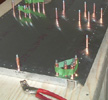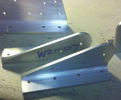


random user submitted photo
Internal corrosion
5 posts
• Page 1 of 1
Internal corrosion
So we have our Aerovee apart now. The bearings look pretty terrible, and there is corrosion on the crankshaft and connecting rods. I have some pictures at https://blog.familjenjonsson.org/blog/2017/10/28/engine-guts-part-1/.
Has anyone had their engine apart and had their bearings look like that? The corrosion clearly is from lack of use in combination with the climate here. The front of the crankshaft is covered in corrosion. If any one you saw my post with the corroded prop bolts, I think the attitude of the tailwheel airplane when parked, in combination with the bolt holes in the spinner is letting water collect and seep in along the bolts.
I think there's a similar thing going on with the prop shaft. When it rains, water can run backward along the bottom of the prop shaft. Since there's no seal at this location, it can continue into the case until it hits the oil slinger, where it will drip off and end up in the sump.
I hadn't really thought about this aspect of the design before, but it really does not seem like the lack of front seal and tailwheel attitude go well together. Our crankshaft appears to be worn beyond limits, so I'm strongly considering changing to the "Force One" hub from Great Plains when replacing it since it not only adds a larger front bearing but, more importantly in this context, also has a real seal at the front of the engine.
Has anyone had their engine apart and had their bearings look like that? The corrosion clearly is from lack of use in combination with the climate here. The front of the crankshaft is covered in corrosion. If any one you saw my post with the corroded prop bolts, I think the attitude of the tailwheel airplane when parked, in combination with the bolt holes in the spinner is letting water collect and seep in along the bolts.
I think there's a similar thing going on with the prop shaft. When it rains, water can run backward along the bottom of the prop shaft. Since there's no seal at this location, it can continue into the case until it hits the oil slinger, where it will drip off and end up in the sump.
I hadn't really thought about this aspect of the design before, but it really does not seem like the lack of front seal and tailwheel attitude go well together. Our crankshaft appears to be worn beyond limits, so I'm strongly considering changing to the "Force One" hub from Great Plains when replacing it since it not only adds a larger front bearing but, more importantly in this context, also has a real seal at the front of the engine.
- lutorm
- Posts: 259
- Joined: Mon May 15, 2017 1:35 pm
- Location: The Island of Hawai
Re: Internal corrosion
Wow, that's amazing! I've never seen or heard of anything like it on a VW. I've had my AeroVee engine apart several times, and everything inside and out looked pristine, including the prop hub, prop bolts and bearings. Mine's a tail dragger living outside. I live about 25 miles from the Atlantic ocean, which is too far for coastal moisture to be a factor at my airport. How is the crank case vented?
Mike Smith
Sonex N439M
Scratch built, AeroVee, Dual stick, Tail dragger
http://www.mykitlog.com/mikesmith
Sonex N439M
Scratch built, AeroVee, Dual stick, Tail dragger
http://www.mykitlog.com/mikesmith
- mike.smith
- Posts: 1406
- Joined: Tue Jan 29, 2013 8:45 pm
Re: Internal corrosion
mike.smith wrote:Wow, that's amazing! I've never seen or heard of anything like it on a VW. I've had my AeroVee engine apart several times, and everything inside and out looked pristine, including the prop hub, prop bolts and bearings. Mine's a tail dragger living outside. I live about 25 miles from the Atlantic ocean, which is too far for coastal moisture to be a factor at my airport. How is the crank case vented?
Hm, interesting. How much does it rain where you live? This plane's been parked under cover in Hawaii for maybe 5 years and then the last year we lost that so it's been out in the rain for the last year or so. The tiedowns are maybe a mile from the ocean so salt in the air might be contributing but it's not usually windy enough to really blow in salt spray.
A compounding issue is probably that the previous owner is on the mainland for large parts of every summer, so the plane sits for several months every year. In the couple of years it hasn't flown very much at all because the Aerovee would overheat. (Hopefully the new intake and more even mixture distribution has fixed that.) How much does your plane fly?
The vent is the normal breather tube going out the top and down to the cowling exit.
- lutorm
- Posts: 259
- Joined: Mon May 15, 2017 1:35 pm
- Location: The Island of Hawai
Re: Internal corrosion
lutorm wrote:Hm, interesting. How much does it rain where you live? This plane's been parked under cover in Hawaii for maybe 5 years and then the last year we lost that so it's been out in the rain for the last year or so. The tiedowns are maybe a mile from the ocean so salt in the air might be contributing but it's not usually windy enough to really blow in salt spray.
A compounding issue is probably that the previous owner is on the mainland for large parts of every summer, so the plane sits for several months every year. In the couple of years it hasn't flown very much at all because the Aerovee would overheat. (Hopefully the new intake and more even mixture distribution has fixed that.) How much does your plane fly?
The vent is the normal breather tube going out the top and down to the cowling exit.
Well, it's not tropical here, but we get our share of heavy rains and the tail ends of hurricanes (several inches of rain and 50mph winds last week). We get about 45" of rain annually. If you're a mile from the ocean that's certainly got to be a factor. I fly about 90 hours per year; weekly when weather permits. I've been flying for 3 years and 270 hours.
I asked about the crankcase breather only because if you return the vapors through an air/oil separator (as I do) but it allows moisture to condense before going back into the engine, then that's a source of constant moisture. But it sounds like yours vents overboard.
As for your engine overheating, the condition of the bearings could have been one of the major reasons. Major friction!
When I had a prop strike I replaced the crank ($350 I believe) and replaced all the bearings. In your case it sounds like the only salvageable part of the engine is the case! Yikes!
Mike Smith
Sonex N439M
Scratch built, AeroVee, Dual stick, Tail dragger
http://www.mykitlog.com/mikesmith
Sonex N439M
Scratch built, AeroVee, Dual stick, Tail dragger
http://www.mykitlog.com/mikesmith
- mike.smith
- Posts: 1406
- Joined: Tue Jan 29, 2013 8:45 pm
Re: Internal corrosion
An update on the state of our engine: The camshaft, lifters, rods, and pistons were deemed to be in good shape by the local VW shop. We've replaced the crankshaft with a Force One crank from Great Plains and the case is now in the shop being bored out to accept the larger bearing. This will also give us a front seal which should avoid water getting into the engine that way. All bearings are obviously being replaced, and we're also adding an oil filter inline with the oil cooler since it's clear both from the condition of the bearings and the major amount of ferromagnetic sludge sitting in the sump that the oil had carried serious amounts of debris through the engine.
- lutorm
- Posts: 259
- Joined: Mon May 15, 2017 1:35 pm
- Location: The Island of Hawai
5 posts
• Page 1 of 1
Who is online
Users browsing this forum: No registered users and 4 guests







